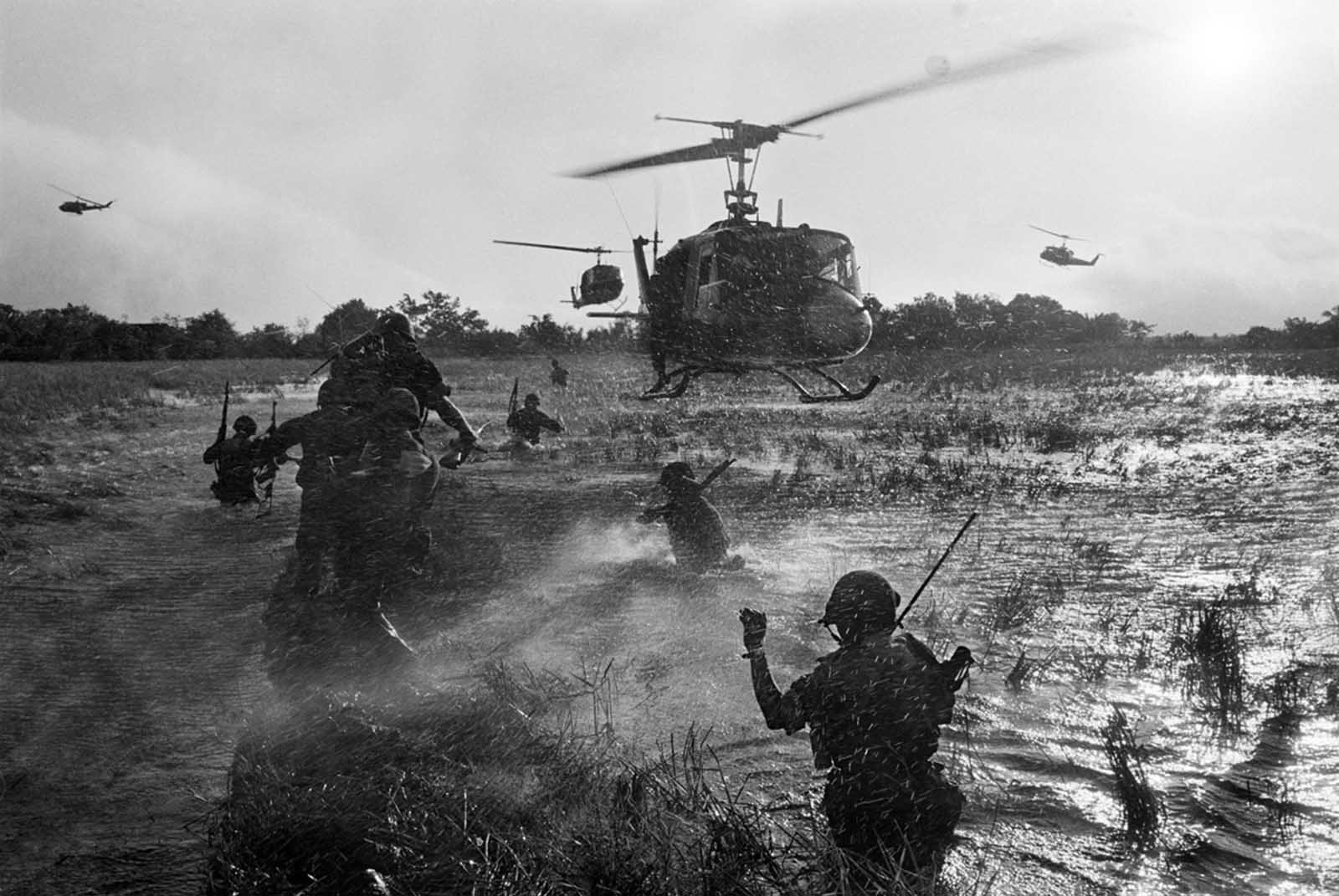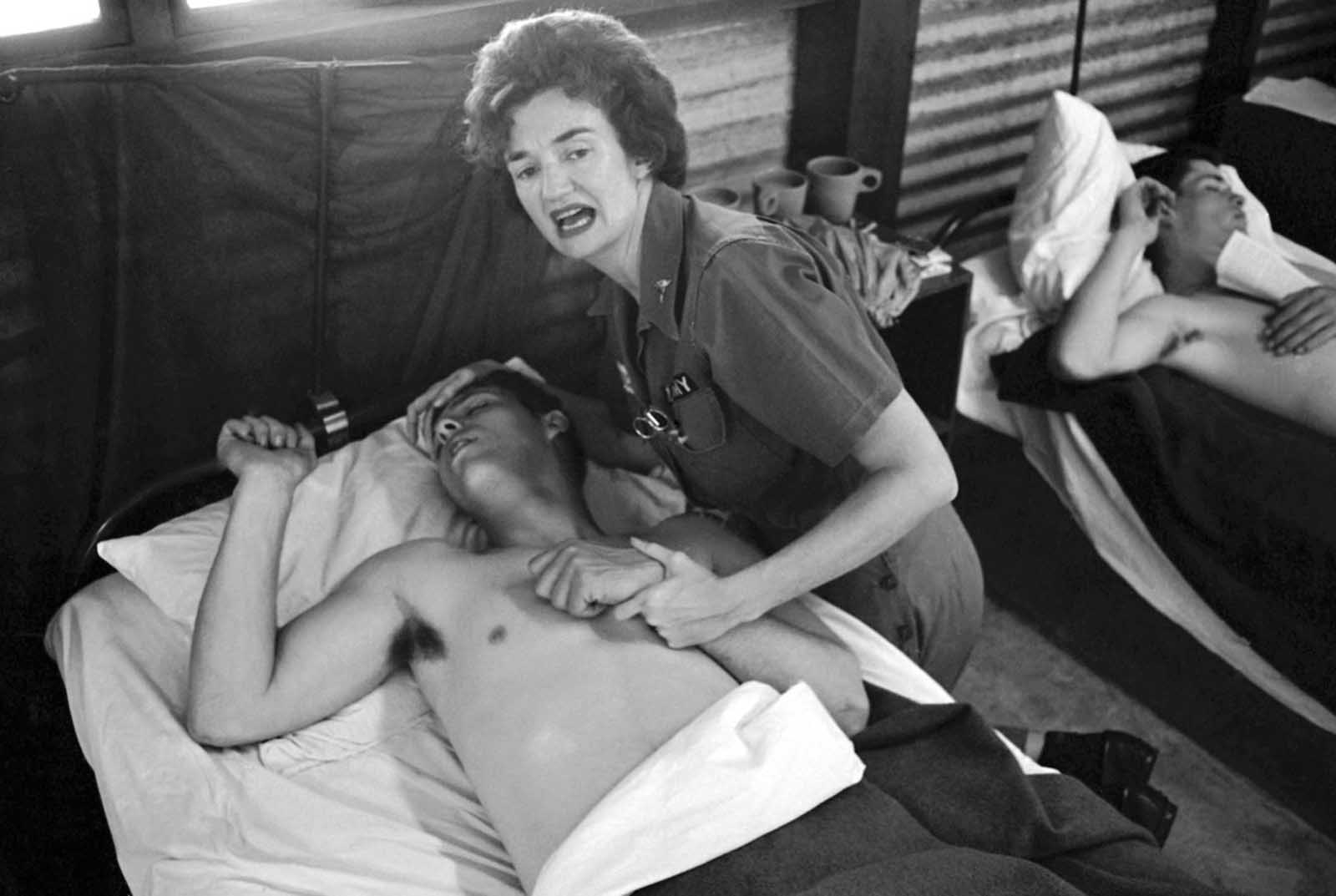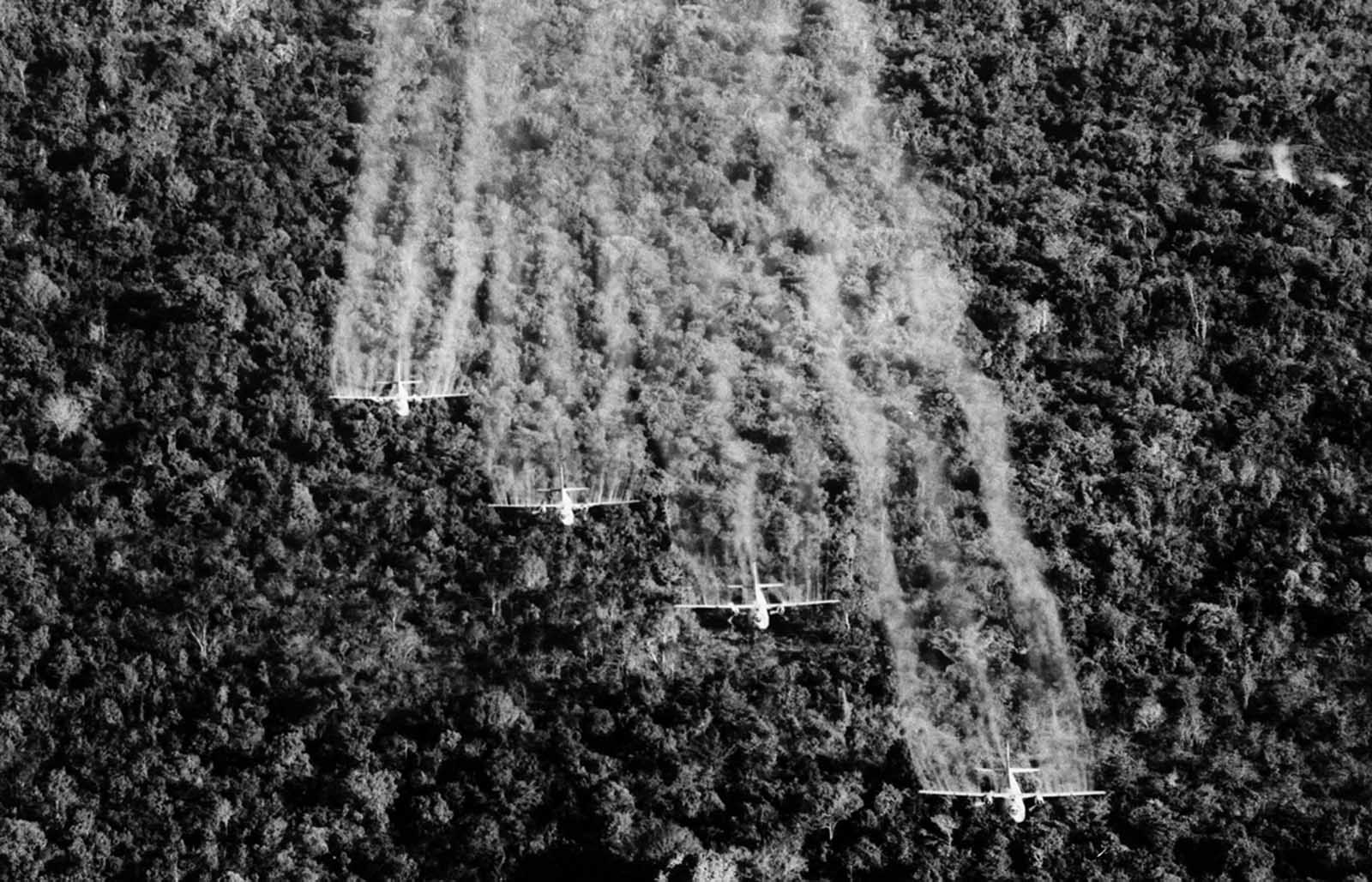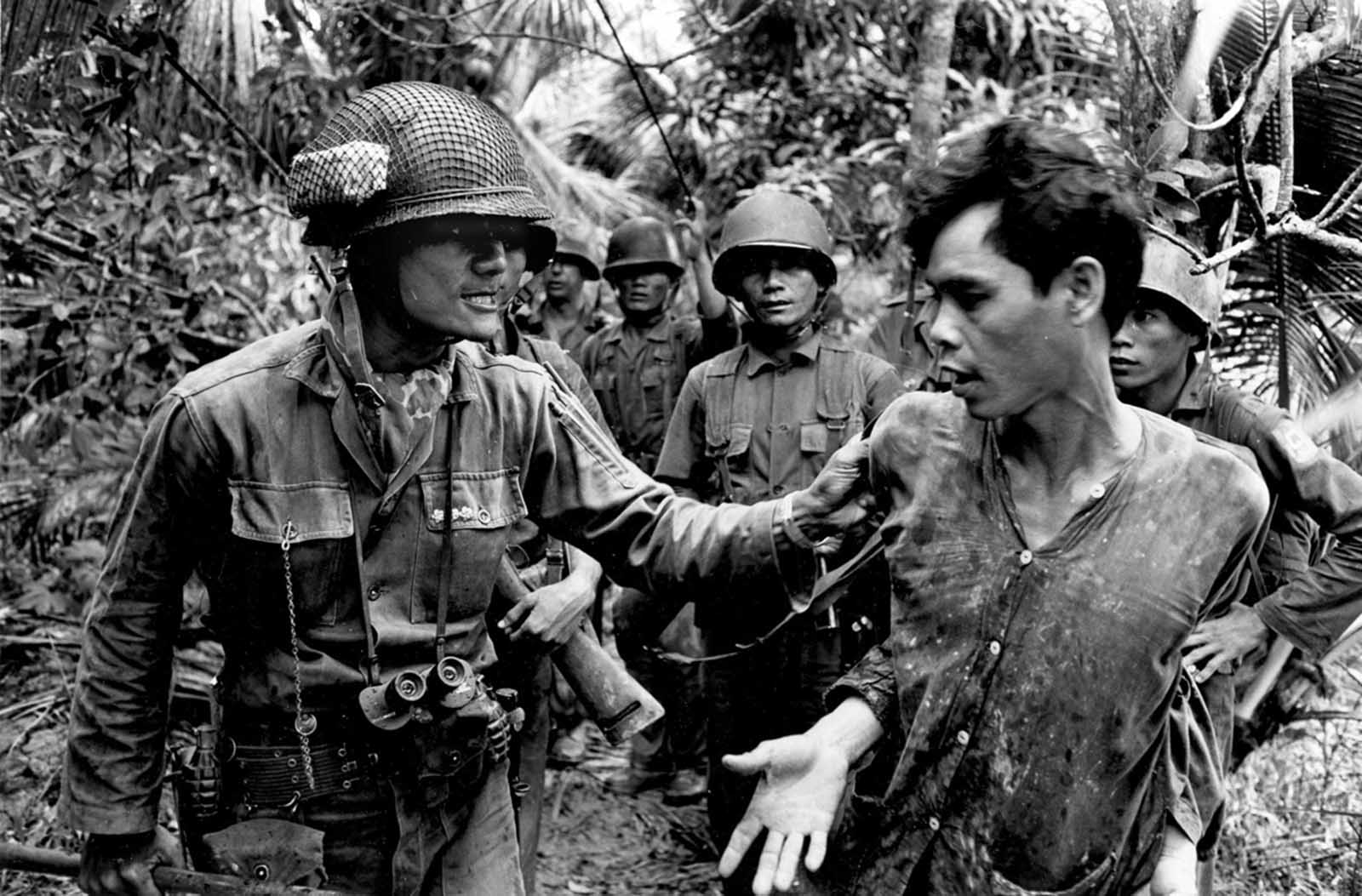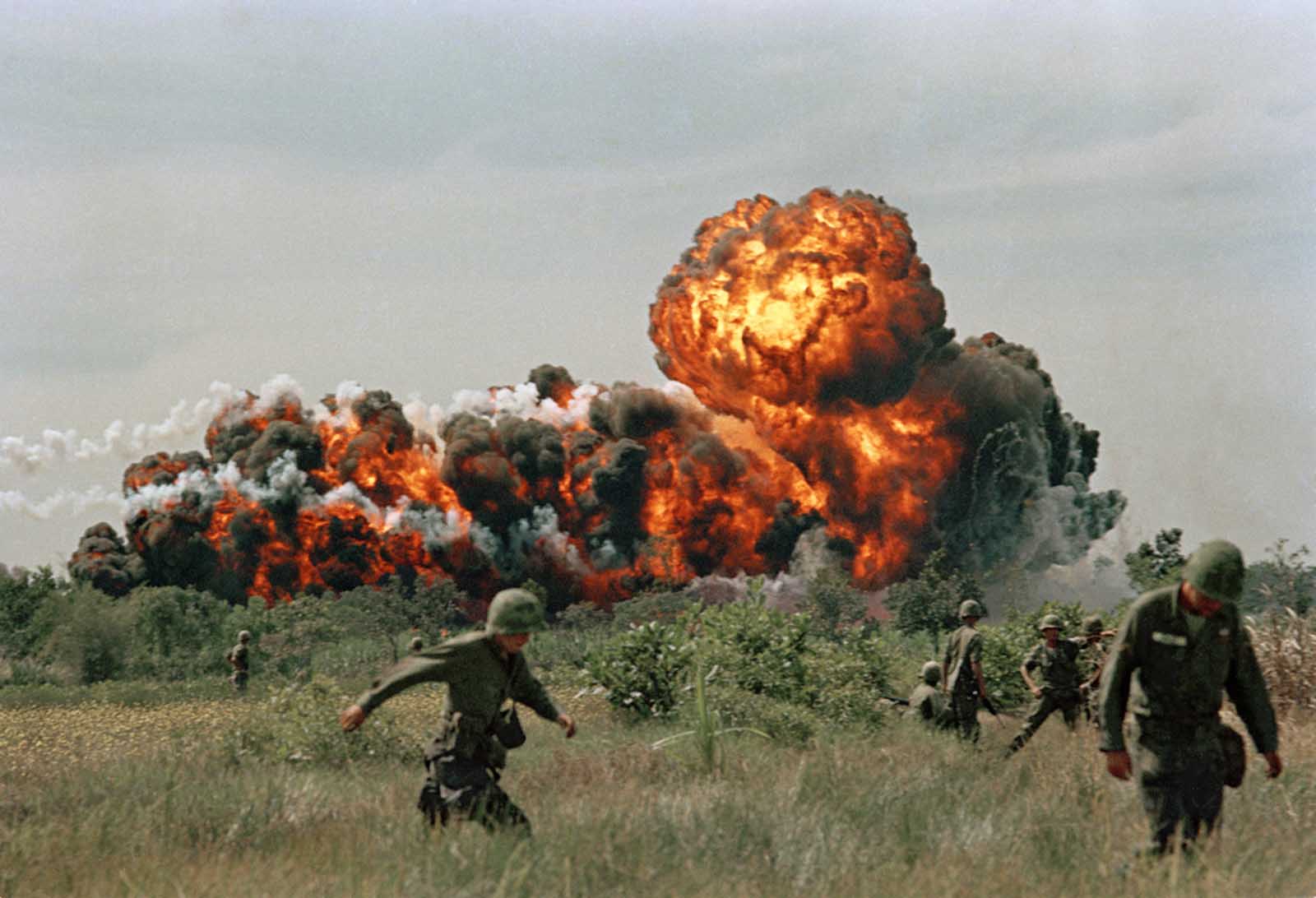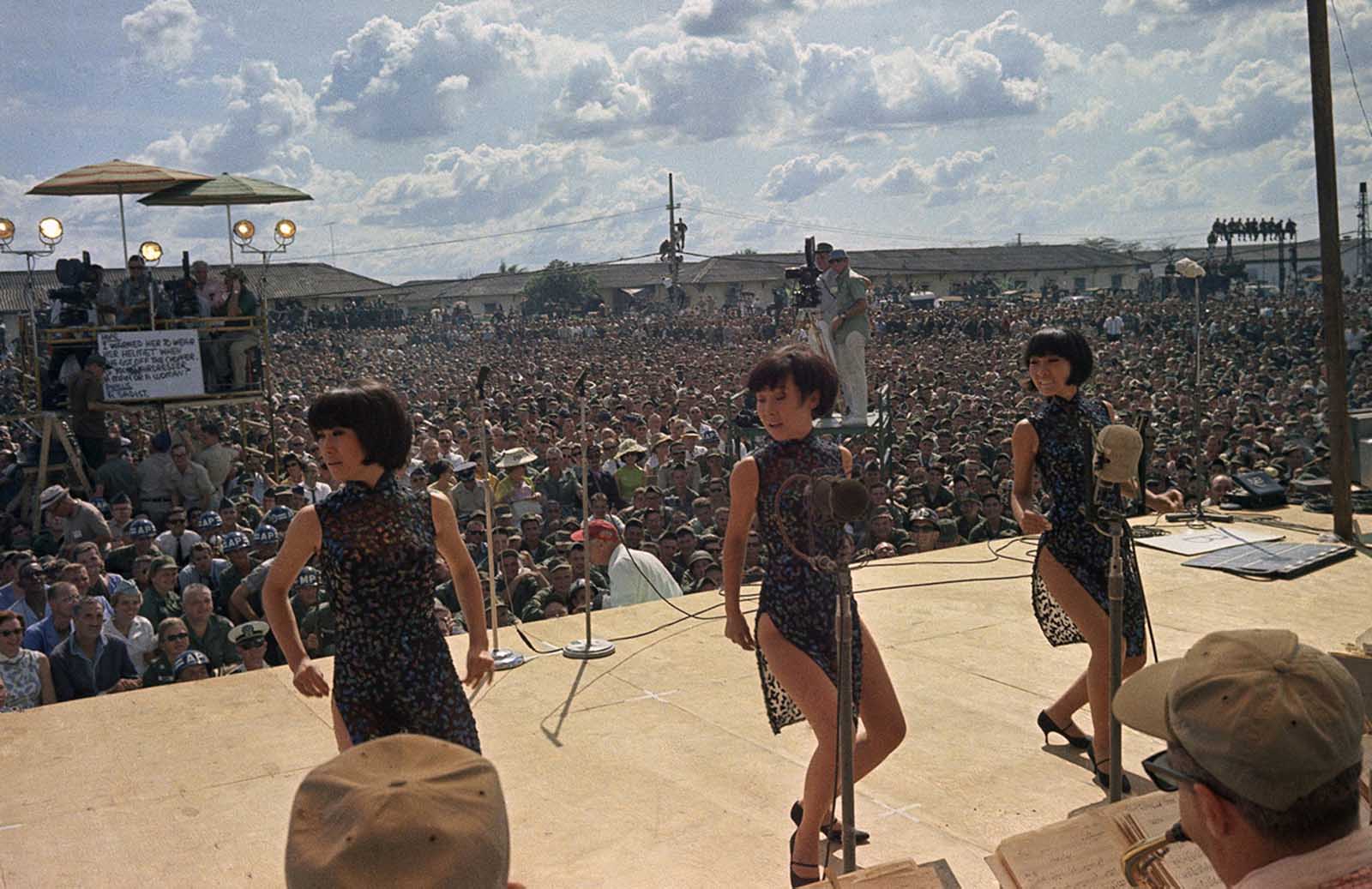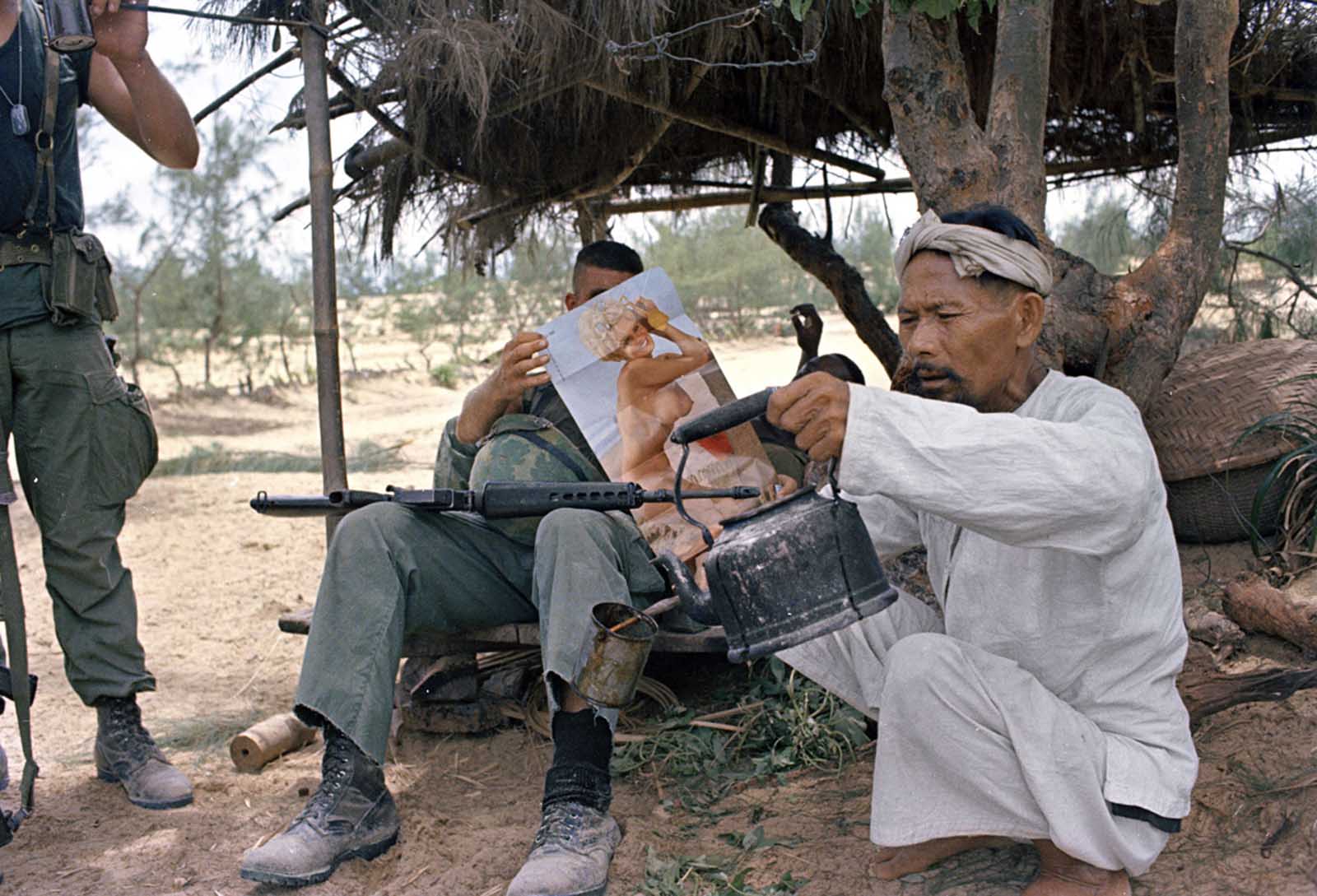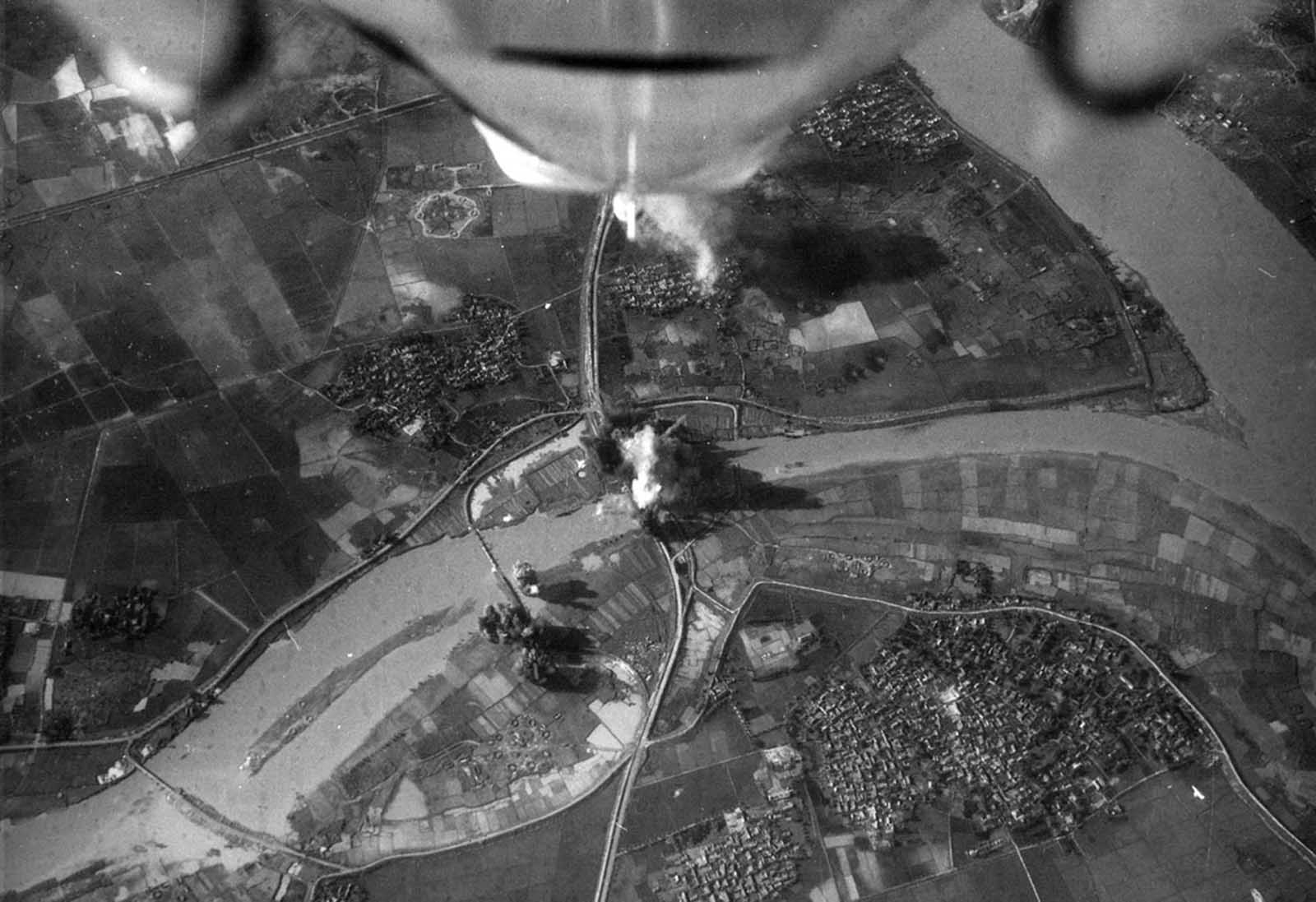On May 07, 1954, Viet Minh forces won the Battle of Dien Bien Phu and ended French involvement in Indochina. This victory led to the Geneva Conference where the French and Viet Minh negotiated a ceasefire agreement. (Note: the other part of this photo collection: Vietnam War: Escalation and Withdrawal through rare photographs, 1968-1975). Under the terms of the Geneva Accords, France agreed to withdraw its troops from Indochina while Vietnam was temporarily divided into North and South Vietnam, led by Ho Chi Minh and Bao Dai respectively, at the 17th parallel. Civilians were able to move freely between two states for a 300-day period. General elections were to be held within two years, by July 1956, to unify the country. However, the accords apparently did not please the United States. First, they feared that the general elections would not be fair and free under the communists’ influence. Second and most importantly, if the communists won in Vietnam, communism could spread throughout Southeast Asia and become a greater threat to the U.S. In a letter to Ngo Dinh Diem – the new Prime Minister of the Bao Dai government on October 23, 1954, President Dwight D. Eisenhower promised American support to his government to ensure a non-communist Vietnam. Following through on that commitment, American aid to South Vietnam began as early as January 1955. The Military Assistance Advisory Group (MAAG), Indochina was also re-organized into MAAG, Vietnam to train the South Vietnamese army. By early 1955, Diem had consolidated his power and control over South Vietnam. He also launched many political repression and anti-communist campaigns across the country, in which 25,000 anti-government activists and communists were arrested and more than 1,000 killed as claimed by the communists. In return, communist insurgents also assassinated hundreds of South Vietnamese officials. In July 1955, Diem rejected the national election, claiming South Vietnam was not bound by the Geneva Accords. In October, he easily ousted Bao Dai and became President of the new Republic of Vietnam (ROV). Nevertheless, Diem’s political repression and attacks on the Buddhist community made him more and more unpopular among ordinary South Vietnamese people. Realizing the increasing unpopularity of Diem regime, Hanoi established the National Liberation Front (NLF), better known as the Viet Cong, on December 20, 1960, which consisted of all anti-government activists – both communists and non-communists, as a common front to fight against Diem. In May 1961, Kennedy sent 400 U.S. Army Special Forces (Green Beret) troops into South Vietnam’s Central Highlands to train Montagnard tribesmen in counterinsurgency tactics. He also tripled the level of aid to South Vietnam. A steady stream of airplanes, helicopters, armored personnel carriers (APCs), and other equipment poured into the South. By the end of 1962, there were 9,000 U.S. military advisers under the direction of a newly‐created Military Assistance Command Vietnam (MACV), commanded by U.S. Army Gen. Paul Harkins. Under U.S. guidance, the Diem government also began construction of “strategic hamlets.” These fortified villages were intended to insulate rural Vietnamese from Vietcong intimidation and propaganda. U.S. and South Vietnamese leaders were cautiously optimistic that increased U.S. assistance finally was enabling the Saigon government to defend itself. On 2 January 1963, however, at Ap Bac on the Plain of Reeds southwest of Saigon, a Vietcong battalion of about 320 men inflicted heavy damage on an ARVN force of 3,000 equipped with troop‐carrying helicopters, new UH‐1 (“Huey”) helicopter gunships, tactical bombers, and APCs. Ap Bac represented a leadership failure for the ARVN and a major morale boost for the anti-government forces. The absence of fighting spirit in the ARVN mirrored the continuing inability of the Saigon regime to win political support. Indeed, many South Vietnamese perceived the strategic hamlets as government oppression, not protection, because people were forced to leave their ancestral homes for the new settlements. While Vietcong guerrillas scored military successes, leaders of Vietnam’s Buddhist majority protested against what they saw as the Diem regime’s religious persecution. In June, a monk dramatically burned himself to death at a busy Saigon intersection. The “Buddhist crisis” and dissatisfaction with Diem by top Vietnamese Army leaders made U.S. officials receptive to the idea of a change in South Vietnam’s leadership. Ambassador Henry Cabot Lodge and the Central Intelligence Agency (CIA) did not interfere as a group of ARVN officers plotted a coup. On 1 November 1963, the generals seized power, and Diem and his unpopular brother Ngo Dinh Nhu were murdered. Three weeks later, President Kennedy was assassinated, and U.S. policy in Vietnam was again at a crossroads. If the new government in Saigon failed to show progress against the insurgency, would the United States withdraw its support from a lost cause, or would it escalate the effort to preserve South Vietnam as an anti-communist outpost in Asia? Lyndon B. Johnson inherited the Vietnam dilemma. As Senate majority leader in the 1950s and as vice‐president, he had supported Eisenhower’s and Kennedy’s decisions to aid South Vietnam. Four days after Kennedy’s death, Johnson, now president, reaffirmed in National Security Action Memorandum (NSAM) 273 that the U.S. goal was to assist South Vietnam in its “contest against the externally directed and supported communist conspiracy.” U.S. policy defined the Vietnam War as North Vietnamese aggression against South Vietnam. North Vietnam infiltrated troops and matériel into South Vietnam by sea and along the so‐called Ho Chi Minh Trail in Laos. Throughout his administration, Johnson insisted that the only possible negotiated settlement of the conflict would be one in which North Vietnam recognized the legitimacy of South Vietnam’s government. Without such recognition, the United States would continue to provide Saigon as much help as it needed to survive. The critical military questions were how much U.S. assistance was enough and what form it should take. By the spring of 1964, the Vietcong controlled vast areas of South Vietnam, the strategic hamlet program had essentially ceased, and North Vietnam’s aid to the southern insurgents had grown. In June, Johnson named one of the army’s most distinguished officers, Gen. William C. Westmoreland, then commandant of West Point, as commander U.S. MACV. Westmoreland immediately asked for more men, and by the end of 1964 U.S. personnel in the South exceeded 23,000. Increasingly, however, the U.S. effort focused on the North. Secretary of Defense Robert S. McNamara, Secretary of State Dean Rusk, and other key White House aides remained convinced that the assault on South Vietnam originated in the ambitious designs of Hanoi backed by Moscow and Beijing. Throughout 1964, the United States assisted South Vietnam in covert operations to gather intelligence, disseminate propaganda, and harass the North. On the night of 2 August, North Vietnamese gunboats fired on the USS Maddox, a destroyer on an intelligence‐collecting mission, in the same area of the Gulf of Tonkin where South Vietnamese commandos were conducting raids against the North Vietnamese coast. Two nights later, under stormy conditions, the Maddox and another destroyer, the Turner Joy, reported a gunboat attack. Although doubts existed about these reports, the president ordered retaliatory airstrikes against the North Vietnamese port of Vinh. The White House had expected that some type of incident would occur eventually, and it had prepared the text of a congressional resolution authorizing the president to use armed force to protect U.S. forces and to deter further aggression from North Vietnam. On 7 August 1964, Johnson secured almost unanimous consent from Congress (414–0 in the House; 88–2 in the Senate) for his Gulf of Tonkin Resolution, which became the principal legislative basis for all subsequent military deployment in Southeast Asia. Johnson’s decisive but restrained response to the Gulf of Tonkin incidents helped him win the 1964 election, but Saigon’s prospects continued to decline. The president wanted to concentrate on his ambitious domestic program, the Great Society, but his political instincts told him that his leadership would be damaged fatally if America’s client state in South Vietnam succumbed. Instability mounted in South Vietnam as rival military and civilian factions vied for power and as Vietcong strength grew. A consensus formed among Johnson’s advisers that the United States would have to initiate air warfare against North Vietnam. Bombing could boost Saigon’s morale and might persuade the North to cease its support of the insurgency. The Joint Chiefs of Staff (JCS) favored a massive bombing campaign, but civilians in the State and Defense Departments preferred a gradual escalation. Using as a pretext a Vietcong attack on 7 February 1965 at Pleiku that killed eight American soldiers, Johnson ordered retaliatory bombing north of the Demilitarized Zone along the 17th parallel that divided North and South Vietnam. Within a week, the administration began ROLLING THUNDER, a gradually intensifying air bombardment of military bases, supply depots, and infiltration routes in North Vietnam. Flying out of bases in Thailand, U.S. Air Force fighter‐bombers—primarily F‐105 Thunderchiefs and later F‐4 Phantoms—joined U.S. Navy Phantoms and A‐4 Skyhawks from a powerful carrier task force located at a point called Yankee Station, seventy‐five miles off the North Vietnamese coast in the Gulf of Tonkin. In 1965, U.S. aircraft flew 25,000 sorties against North Vietnam, and that number grew to 79,000 in 1966 and 108,000 in 1967. In 1967 annual bombing tonnage reached almost a quarter million. Targets expanded to include the Ho Chi Minh Trail in Laos and factories, farms, and railroads in North Vietnam. From the beginning of the bombing, American strategists debated the effectiveness of airpower in defeating a political insurgency in a predominantly agricultural country. Despite the American bombs, dollars, and military advisers, the Vietcong continued to inflict heavy casualties on the ARVN, and the political situation in Saigon grew worse. By June 1965, there had been five governments in the South since Diem’s death, and the newest regime, headed by General Nguyen Van Thieu and Air Marshall Nguyen Cao Ky, inspired little confidence. To stave off defeat, the JCS endorsed Westmoreland’s request for 150,000 U.S. troops to take the ground offensive in the South. When McNamara concurred, Johnson decided to commit the forces. The buildup of formal U.S. military units had begun on 8 March 1965, when two battalions of Marines landed at Da Nang. In June, Marine and army units began offensive unit operations—“search and destroy” missions. On 28 July, Johnson announced that 50,000 U.S. troops would go to South Vietnam immediately. By the end of the year, there were 184,300 U.S. personnel in the South. Although Johnson’s actions meant that the United States had crossed the line from advising the ARVN to actually fighting the war against the Vietcong, the president downplayed the move. The JCS wanted a mobilization of the reserves and National Guard, and McNamara proposed levying war taxes. Such actions would have placed the United States on a war footing. With his ambitious social reform program facing crucial votes in Congress, the president wanted to avoid giving congressional conservatives an opportunity to use mobilization to block his domestic agenda. Consequently, he relied on other means. Monthly draft calls increased from 17,000 to 35,000 to meet manpower needs, and deficit spending, with its inherent inflationary impact, funded the escalation. With U.S. bombs pounding North Vietnam, Westmoreland turned America’s massive firepower on the southern insurgents. Johnson’s choice of gradual escalation of bombing and incremental troop deployments was based upon the concept of limited warfare. Risks of a wider war with China and the Soviet Union meant that the United States would not go all out to annihilate North Vietnam. Thus, Westmoreland chose a strategy of attrition in the South. Using mobility and powerful weapons, the MACV commander could limit U.S. casualties while exhausting the enemy, that is, inflicting heavier losses than could be replaced. Escalation of the air and ground war in 1965 provoked Hanoi to begin deploying into the South increasing units of the regular North Vietnamese Army (NVA), or People’s Army of Vietnam (PAVN), as it was called. In October, Gen. Vo Nguyen Giap, the PAVN commander, launched a major offensive in the Central Highlands, southwest of Pleiku. Westmoreland responded with the 1st Air Cavalry Division (Air Mobile). Through much of November, in the Battle of the Ia Drang Valley, U.S. and North Vietnamese forces engaged each other in heavy combat for the first time. The Americans ultimately forced the NVA out of the valley and killed ten times as many enemy soldiers as they lost. Westmoreland used helicopters extensively for troop movements, resupply, medical evacuation, and tactical air support. USAF tactical bombers and even huge B‐52 strategic bombers attacked enemy positions. The battle convinced the U.S. commander that “search and destroy” tactics using air mobility would work in accomplishing the attrition strategy. Soon after the PAVN departed the battlefield, however, so too did the American air “cavalry.” Clearly, control of territory was not the U.S. military objective. During 1966 Westmoreland requested more ground troops, and by year’s end the U.S. ground force level “in country” reached 385,000. These were organized into seven divisions and other specialized airborne, armored, special forces, and logistical units. With U.S. aid, the ARVN also expanded to eleven divisions, supplemented by local and irregular units. While MACV was getting men and munitions in place for large‐unit search and destroy operations, army and marine units conducted smaller operations. Although the “body count”—the estimated number of enemy killed—mounted, attrition was not changing the political equation in South Vietnam. The NLF continued to exercise more effective control in many areas than did the government, and Vietcong guerrillas, who often disappeared when U.S. forces entered an area, quickly reappeared when the Americans left. In 1967, Westmoreland made his big push to win the war. With South Vietnam’s forces assigned primarily to occupation, pacification, and security duties, massive U.S. combat sweeps moved to locate and destroy the enemy. In January, Operation Cedar Falls was a 30,000‐man assault on the Iron Triangle, an enemy base area forty miles north of Saigon. From February through April, Operation Junction City was an even larger attack on nearby War Zone C. There was major fighting in the Central Highlands, climaxing in the battle of Dak To in November 1967. U.S. forces killed many enemy soldiers and destroyed large amounts of supplies. MACV declared vast areas to be “free‐fire zones,” which meant that U.S. and ARVN artillery and tactical aircraft, as well as B‐52 “carpet bombing,” could target anyone or anything in the area. In Operation RANCH HAND, the USAF sprayed the defoliant Agent Orange to deprive the guerrillas of cover and food supplies. Controversy about the use of Agent Orange erupted in 1969 when reports appeared that the chemical caused serious damage to humans as well as to plants. Late in 1967, with 485,600 U.S. troops in Vietnam, Westmoreland announced that, although much fighting remained, a cross‐over point had arrived in the war of attrition; that is, the losses to the NVA and Vietcong were greater than they could replace. This assessment was debatable, and there was considerable evidence that the so‐called “other war” for political support in South Vietnam was not going well. Corruption, factionalism, and continued Buddhist protests plagued the Thieu‐Ky government. Despite incredible losses, the Vietcong still controlled many areas. A diplomatic resolution of the conflict remained elusive. Several third countries, such as Poland and Great Britain, offered proposals intended to facilitate negotiations. These formulas typically called upon the United States and DRV to coordinate mutual reduction of their military activities in South Vietnam, but both Washington and Hanoi firmly resisted even interim compromises with the other. The war was at a stalemate. (Photo credit: U.S. Navy / AP / Library of Congress). Notify me of new posts by email.
Δ Subscribe








